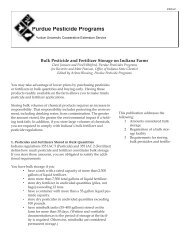Pesticides and Risk Communication PPP-52 - Purdue Pesticide ...
Pesticides and Risk Communication PPP-52 - Purdue Pesticide ...
Pesticides and Risk Communication PPP-52 - Purdue Pesticide ...
You also want an ePaper? Increase the reach of your titles
YUMPU automatically turns print PDFs into web optimized ePapers that Google loves.
That’s Not What They Said<br />
There often is conflicting evidence on an issue, which is inevitably<br />
brought up by someone in the audience. If you have done your homework,<br />
you are aware of the conflict <strong>and</strong> prepared to address it. Briefly<br />
state both points of view, then demonstrate your justification for the<br />
stance you have taken.<br />
Key Points<br />
Begin <strong>and</strong> end your talk by stating your key points. Plan your presentation<br />
around a few major points <strong>and</strong>, as you begin, tell the audience<br />
what they are. Communicate your take-home message <strong>and</strong> emphasize<br />
its importance. At the end of your presentation, ask the audience to restate<br />
your key points; if they leave some out, bill in the blanks as you<br />
conclude.<br />
It Doesn’t Have to Be My Way Every Time<br />
<strong>Risk</strong>s loom large when they are involuntary or even feel imposed.<br />
For instance, farmers are upset to learn that EPA may take a popular,<br />
inexpensive, effective pesticide off the market, thus increasing the cost<br />
of crop production. But explaining what farmers can do to keep the<br />
product on the market affords them an opportunity to impact EPA’s final<br />
decision. People who do not want pesticides applied to or near their<br />
property have a right to influence the decision, as well.<br />
Your job as a risk communicator is to inform your audience of their<br />
choices <strong>and</strong> the probable, corresponding consequences. If there are<br />
several solutions to a complex problem <strong>and</strong> each is technically equal, it<br />
is likely that the ultimate decision will reflect the values of the majority<br />
affected. And when people are thus allowed to exercise some control,<br />
they feel more confident in the decision.<br />
No Way Do I Believe It’s Not <strong>Risk</strong>y<br />
Confrontational remarks such as “There’s no way that I believe it’s<br />
not risky” bring everyone to the edge of their seats, awaiting your<br />
response. Ask the person who commented what it is that they don’t<br />
believe, <strong>and</strong> respond with a calm, rational discussion. In many cases,<br />
it’s simply best to say that it is all right to disagree, that you recognize<br />
<strong>and</strong> respect their position, <strong>and</strong> that you hope they can appreciate yours.<br />
46




